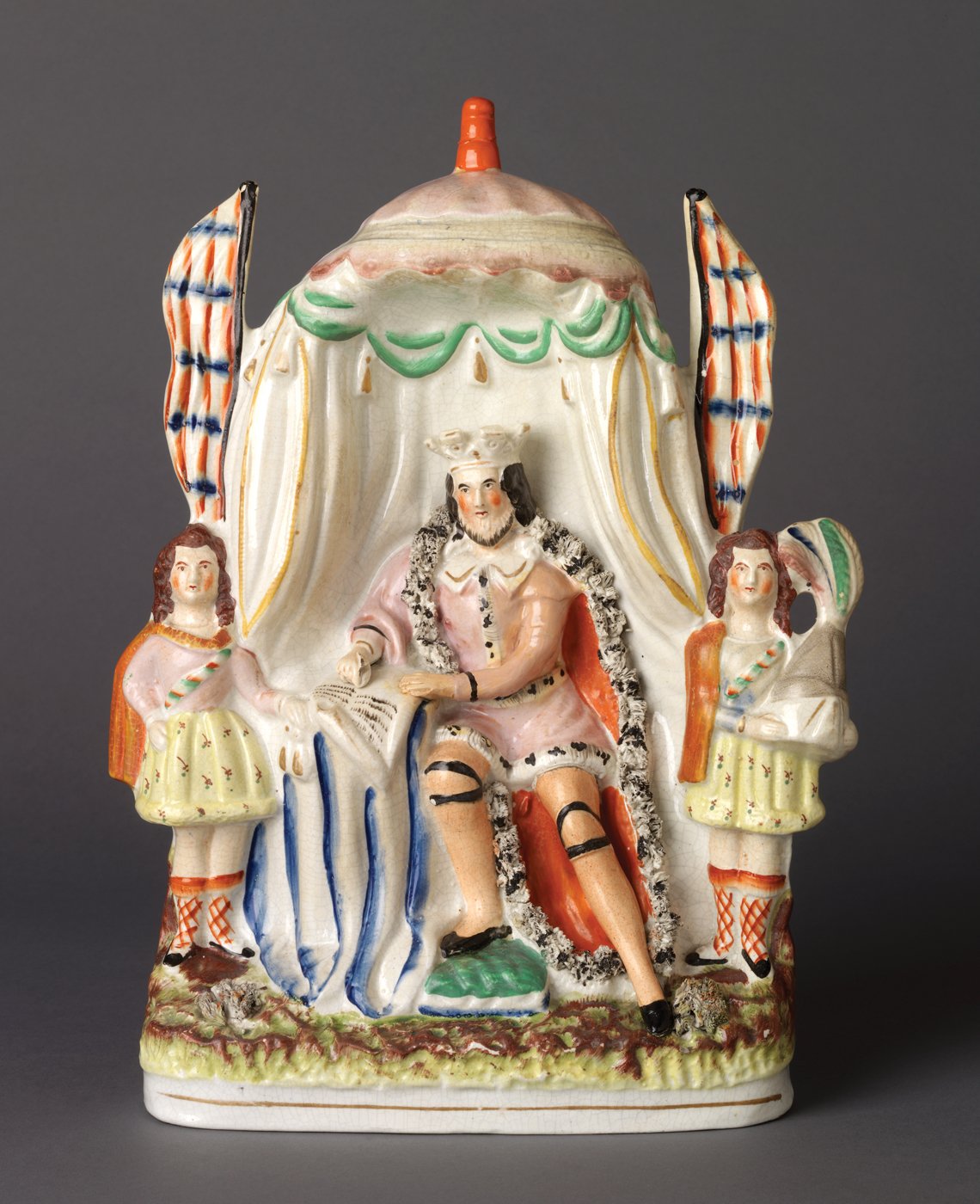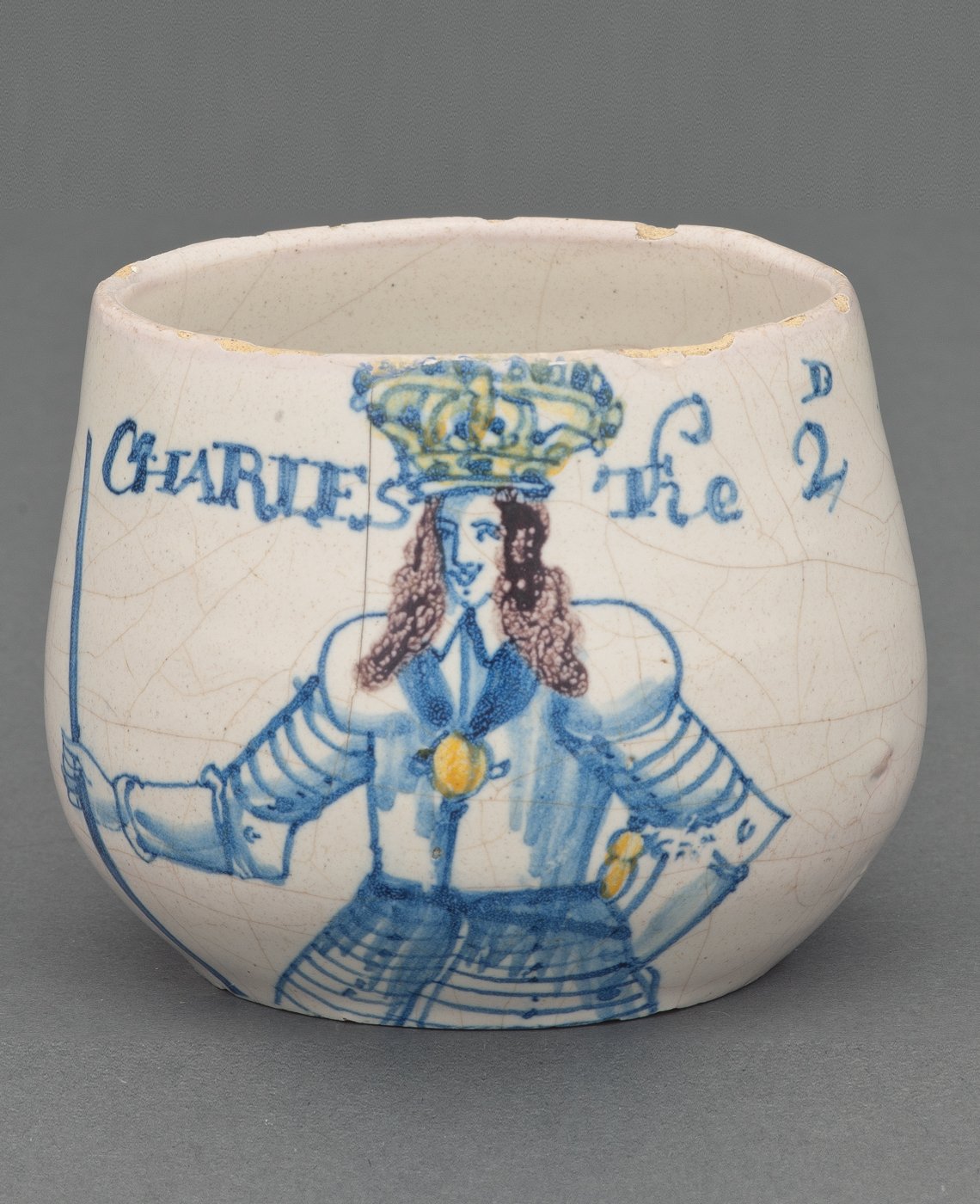Winterthur Primer: Fit for a King (or Queen)
Ceramics and the British Monarchy
Growing up with ceramics-loving Anglophiles, I became obsessed with British culture, with a special affection for the monarchy. In this, I was not alone, as evidenced by the many earthenware, stoneware, and porcelain objects commemorating kings and queens created over the centuries.
Nineteenth-century Staffordshire figures not only celebrated contemporary kings and queens, but also portrayed much earlier ones, some of whom were commemorated in plays by William Shakespeare. One “flatback”—a figure type commonly displaying relief ornament and coloring on the front, only—portrays King John, who signed the charter of rights called Magna Carta in 1215 (Fig. 1). Another depicts the famous fifteenth-century monarch Henry V and was inspired by published images of the famous Shakespearian actor George Rignold (Fig. 2).
Seventeenth-century English monarchs were sometimes commemorated on delft dishes and beverage ware. Such objects typically were less costly than portrait prints or paintings. One rare cup or mug (Fig. 3) depicts King Charles II, identified as “CHARLES The 2D.” Although armor was no longer commonly worn on the battlefield, the king’s costume indicated that he was an important military leader.
On ceramics, some monarchs were identified by their initials only. This is true of an early eighteenth-century German stoneware jug decorated in blue and purple (Fig. 4). Created for consumers in Britain and her colonies, the vessel displays a large stamped-relief pad with a crown and the initials “AR.” The letters refer to Anna Regina, Latin for Queen Anne. Many other jugs bear the initials “GR,” which on vessels from before 1702 can refer to King William III (Gulelmus Rex). On vessels made from 1714 onward, the “GR” stands for King George (Georgious Rex) I, II or III.
 |  | |
Left Fig. 1: Earthenware figure of King John (r. 1199–1216) signing Magna Carta, Staffordshire, England, 1850–1860. Winterthur; Gift of Thomas N. and A. Pat Bernard (2002.0030.145). Right Fig. 2: Earthenware figure of Henry V (r. 1413–1422) as played by actor George Rignold, Sampson Smith factory, Staffordshire, England, 1875–1900. Winterthur; Gift of Thomas N. and A. Pat Bernard (2002.0030.144). | ||
 |  | |
| Left Fig. 3: Tin-glazed earthenware (delftware) mug portraying Charles II (r. 1660–1685), Lambeth (now in London), England, 1660–1685. Winterthur; Bequest of Henry Francis du Pont (1954.0536). Right Fig. 4: Stoneware jug initialed for Queen Anne (r. 1702–1714), Westerwald, Germany, 1702–1714. Winterthur; Museum purchase (1977.0046). | ||
 |  | |
| Left Fig. 5: Stoneware (jasper) medallion portraying George III (r. 1760–1820), Wedgwood Etruria Works, Staffordshire, England, 1775–1780. Winterthur; Gift of Lindsay Grigsby (2005.0010). Right Fig. 6: Cream-colored earthenware sample jug portraying George III (r. 1760–1820), Herculaneum Factory, Liverpool, England, 1809–1810. Winterthur; Gift of S. Robert Teitelman, Roy T. Lefkoe, and Sydney Ann Lefkoe in memory of S. Robert Teitelman (2009.0023.018). | ||
As the 1700s progressed, greater average incomes, as well as efficiencies in trade and ceramics manufacture, allowed a broader swath of society to afford ornamented wares. By the time George III took the throne in 1760, such objects were readily obtainable by a growing middle class. The great Staffordshire pottery owner and entrepreneur, Josiah Wedgwood (1730–1795), provided a range of ceramics portraying monarchs and nobility. Blue and white medallions made in Wedgwood’s so-called jasperware—named for its resemblance to a type of rock found in Nature—featured portraits of George III (Fig. 5) and sometimes were set in gold mounts, to be worn as jewelry.
Another portrait of George III appears on an enormous so-called sample jug made by the Herculaneum Factory in Liverpool in the early 1800s (Fig. 6). The vessel also displays the royal arms, and other motifs declare the royalist sentiments “SUCCESS TO THE CROWN” and hail “KING AND CONSTITUTION.” Post-dating the Revolution, such an object would not have found favor in America. Instead, it was made to be displayed in the shops of English merchants, whose patrons could select from the designs on the jug and have them reproduced on their own special-order wares.
As the nineteenth century progressed, potters in Britain and those supplying British markets created ceramics celebrating current kings and queens from George IV to Victoria and later monarchs. Often produced in affordable wares, these objects not only were popular in Britain, but they also found favor with consumers in former colonies, including America.
Leslie B. Grigsby is senior curator of ceramics and glass, Winterthur Museum, Garden, and Library, Winterthur, Delaware.
 |
This article was originally published in the 20th Anniversary (Spring/Summer 2020) issue of Antiques & Fine Art magazine, a fully digitized version of which is available at www.afamag.com. AFA is affiliated with Incollect.com.



























